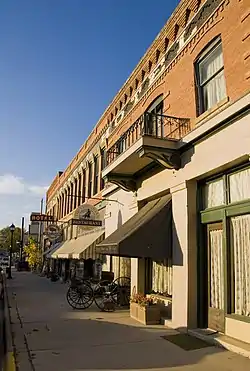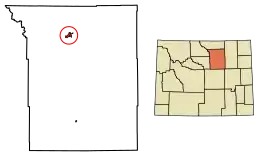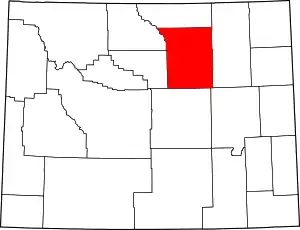Buffalo, Wyoming
Buffalo is a city in Johnson County, Wyoming, United States. The city is located almost equidistant between Yellowstone Park and Mount Rushmore. The population was 4,415 at the 2020 census,[3] down from 4,585 at the 2010 census. It is the county seat of Johnson County.[5] The city has experienced an economic boom due to methane production from the Coal Bed Methane Extraction method used in the Powder River Basin and surrounding areas.[6] However, with the decline of methane production, Buffalo's population has stabilized since the 2010 Census. Even though energy is a vital part of its economy, agriculture, tourism, and recreation are three other major components. Buffalo is located at the foot of the Bighorn Mountains.
Buffalo, Wyoming | |
|---|---|
 Occidental Hotel in Buffalo | |
 Location of Buffalo in Johnson County, Wyoming | |
| Coordinates: 44°20′33″N 106°42′50″W[1] | |
| Country | United States |
| State | Wyoming |
| County | Johnson |
| Government | |
| • Mayor | Shane J. Schrader |
| Area | |
| • Total | 4.48 sq mi (11.61 km2) |
| • Land | 4.48 sq mi (11.61 km2) |
| • Water | 0.00 sq mi (0.00 km2) |
| Elevation | 4,708 ft (1,435 m) |
| Population | |
| • Total | 4,415 |
| • Density | 1,020.98/sq mi (394.22/km2) |
| Time zone | UTC−7 (Mountain (MST)) |
| • Summer (DST) | UTC−6 (MDT) |
| ZIP codes | 82834, 82840 |
| Area code | 307 |
| FIPS code | 56-10685[4] |
| GNIS feature ID | 2409934[1] |
| Website | Official website |
Demographics
| Census | Pop. | Note | %± |
|---|---|---|---|
| 1890 | 1,087 | — | |
| 1900 | 710 | −34.7% | |
| 1910 | 1,368 | 92.7% | |
| 1920 | 1,772 | 29.5% | |
| 1930 | 1,749 | −1.3% | |
| 1940 | 2,302 | 31.6% | |
| 1950 | 2,674 | 16.2% | |
| 1960 | 2,907 | 8.7% | |
| 1970 | 3,394 | 16.8% | |
| 1980 | 3,799 | 11.9% | |
| 1990 | 3,302 | −13.1% | |
| 2000 | 3,900 | 18.1% | |
| 2010 | 4,585 | 17.6% | |
| 2020 | 4,415 | −3.7% | |
| U.S. Decennial Census | |||
2010 census
As of the census[7] of 2010, there were 4,585 people, 2,080 households, and 1,198 families living in the city. The population density was 1,028.0 inhabitants per square mile (396.9/km2). There were 2,300 housing units at an average density of 515.7 per square mile (199.1/km2). The racial makeup of the city was 95.5% White, 0.3% African American, 1.6% Native American, 0.7% Asian, 0.8% from other races, and 1.2% from two or more races. Hispanic or Latino of any race were 3.5% of the population.
There were 2,080 households, of which 26.8% had children under the age of 18 living with them, 45.4% were married couples living together, 8.7% had a female householder with no husband present, 3.6% had a male householder with no wife present, and 42.4% were non-families. 37.8% of all households were made up of individuals, and 15.3% had someone living alone who was 65 years of age or older. The average household size was 2.17 and the average family size was 2.88.
The median age in the city was 42.2 years. 23% of residents were under the age of 18; 6.6% were between the ages of 18 and 24; 23.4% were from 25 to 44; 27.7% were from 45 to 64; and 19.4% were 65 years of age or older. The gender makeup of the city was 50.1% male and 49.9% female.
2000 census
As of the census[4] of 2000, there were 3,900 people, 1,718 households, and 1,042 families living in the city. The population density was 1,104.8 people per square mile (426.6/km2). There were 1,842 housing units at an average density of 521.8 per square mile (201.5/km2). The racial makeup of the city was 96.46% White, 0.10% African American, 0.82% Native American, 0.05% Asian, 0.54% from other races, and 2.03% from two or more races. Hispanic or Latino of any race were 1.82% of the population.
There were 1,718 households, out of which 26.1% had children under the age of 18 living with them, 48.8% were married couples living together, 8.4% had a female householder with no husband present, and 39.3% were non-families. 35.3% of all households were made up of individuals, and 16.1% had someone living alone who was 65 years of age or older. The average household size was 2.21 and the average family size was 2.88.
In the city, the population was spread out, with 23.1% under the age of 18, 5.6% from 18 to 24, 22.6% from 25 to 44, 27.1% from 45 to 64, and 21.5% who were 65 years of age or older. The median age was 44 years. For every 100 females, there were 93.5 males. For every 100 females age 18 and over, there were 89.4 males.
The median income for a household in the city was $29,392, and the median income for a family was $40,683. Males had a median income of $28,716 versus $19,688 for females. The per capita income for the city was $19,054. About 6.7% of families and 10.4% of the population were below the poverty line, including 7.0% of those under age 18 and 12.4% of those age 65 or over.
Government and infrastructure
The Wyoming Department of Health Veteran's Home of Wyoming, an assisted living facility for veterans and their dependents, is located in Buffalo.[8][9] The facility was operated by the Wyoming Board of Charities and Reform until that agency was dissolved as a result of a state constitutional amendment passed in November 1990.[10] Buffalo also has an airport named Johnson County Airport/KBYG.
Education
Public education in the city of Buffalo is provided by Johnson County School District #1. Schools serving the city include Meadowlark Elementary School (grades K-2) Cloud Peak Elementary School (grades 3–5), Clear Creek Middle School (grades 6–8), and Buffalo High School (grades 9–12). Buffalo High School was in the national news spotlight after the (former) head football coach, distributed an offensive "hurt feelings report" in November 2011. This attention brought several heated school board meetings and eventually lead to the resignation of Lynch as the head football coach.[11][12]
Buffalo has a public library, the Johnson County Library.[13]
Area media
Newspapers
The Mini Publications Center is a Wyoming non-profit and registered 501 (c)(3) organization,[14] dedicated to helping regional community and small businesses grow and prosper through free and low cost community services, using both print and online media journalism focused on the needs of rural communities. MPC runs an internet café, has a local gallery in the café, and is starting its 14th year publishing a free local community newspaper, The Mini, published twice a week. An online version, BigHornMountainExpress.com, expands to include the whole Big Horn Mountains region of north central Wyoming. MPC runs the BigHornMountainExpress.com as a rural community news site, as well as an educational website, instructing how to write about the arts, their community, and small business advice. The MPC is also working to create a community learning or community college course certification in running a rural community news service and for developing citizen journalists of all ages and backgrounds. They adhere to the best principles of citizen journalism for rural communities.
The Buffalo Bulletin has served as the newspaper of record in Johnson County since 1884.[15] The paper is published once a week on Thursdays. It has been family owned and operated for three generations. Robb Hicks, the current owner and publisher of the paper, purchased the Bulletin from his father Jim Hicks in 1996. Hicks owns newspapers across Wyoming, Montana, South Dakota, Nebraska, Colorado, Idaho, and Washington.[15]
Geography
According to the United States Census Bureau, the city has a total area of 4.46 square miles (11.55 km2), all land.[16]

Transportation
Buffalo is located near the northern terminus of Interstate 25, where it joins with Interstate 90.
The city is served by a general aviation airfield, the Johnson County Airport (Wyoming), which does not have scheduled passenger air service.
Airports in the region which do have airline service include:
- Sheridan (SHR) - Approx. 1/2-hour drive to Buffalo
- Gillette (GCC) - Approx. 1-hour drive to Buffalo
- Casper (CPR) - Approx. 1.5-hour drive to Buffalo
- Billings (BIL) - Approx. 2+hours drive to Buffalo
Public transport
Buffalo and its surroundings are served by the Buffalo Area Transit System which is a paratransit service operated by the Buffalo Senior Center[17] Buffalo Area Transit System also offers trips to Sheridan and Casper.
Intercity bus service to the city is provided by Express Arrow and Jefferson Lines.[18][19]
Climate
According to the Köppen Climate Classification system, Buffalo has a cold semi-arid climate, abbreviated "BSk" on climate maps. The hottest temperature recorded in Buffalo was 106 °F (41 °C) on August 5, 1979, while the coldest temperature recorded was −40 °F (−40 °C) on January 17, 1930.[20]
| Climate data for Buffalo, Wyoming, 1991–2020 normals, extremes 1899–2020 | |||||||||||||
|---|---|---|---|---|---|---|---|---|---|---|---|---|---|
| Month | Jan | Feb | Mar | Apr | May | Jun | Jul | Aug | Sep | Oct | Nov | Dec | Year |
| Record high °F (°C) | 71 (22) |
77 (25) |
78 (26) |
88 (31) |
91 (33) |
102 (39) |
105 (41) |
106 (41) |
101 (38) |
91 (33) |
80 (27) |
71 (22) |
106 (41) |
| Mean maximum °F (°C) | 58.8 (14.9) |
57.6 (14.2) |
68.3 (20.2) |
76.0 (24.4) |
83.2 (28.4) |
91.0 (32.8) |
96.4 (35.8) |
94.6 (34.8) |
90.9 (32.7) |
80.6 (27.0) |
67.7 (19.8) |
58.5 (14.7) |
97.3 (36.3) |
| Average high °F (°C) | 36.0 (2.2) |
36.5 (2.5) |
46.5 (8.1) |
53.4 (11.9) |
62.4 (16.9) |
73.0 (22.8) |
82.8 (28.2) |
81.8 (27.7) |
71.8 (22.1) |
57.2 (14.0) |
44.9 (7.2) |
36.3 (2.4) |
56.9 (13.8) |
| Daily mean °F (°C) | 23.4 (−4.8) |
24.2 (−4.3) |
33.2 (0.7) |
40.5 (4.7) |
49.7 (9.8) |
59.5 (15.3) |
68.0 (20.0) |
66.3 (19.1) |
56.7 (13.7) |
43.4 (6.3) |
32.1 (0.1) |
23.7 (−4.6) |
43.4 (6.3) |
| Average low °F (°C) | 10.7 (−11.8) |
11.9 (−11.2) |
19.9 (−6.7) |
27.6 (−2.4) |
37.0 (2.8) |
45.9 (7.7) |
53.1 (11.7) |
50.8 (10.4) |
41.7 (5.4) |
29.6 (−1.3) |
19.4 (−7.0) |
11.0 (−11.7) |
29.9 (−1.2) |
| Mean minimum °F (°C) | −10.7 (−23.7) |
−6.8 (−21.6) |
3.1 (−16.1) |
15.8 (−9.0) |
26.3 (−3.2) |
36.8 (2.7) |
45.6 (7.6) |
42.6 (5.9) |
29.9 (−1.2) |
14.7 (−9.6) |
1.8 (−16.8) |
−7.8 (−22.1) |
−17.5 (−27.5) |
| Record low °F (°C) | −40 (−40) |
−37 (−38) |
−27 (−33) |
−15 (−26) |
13 (−11) |
27 (−3) |
32 (0) |
30 (−1) |
9 (−13) |
−8 (−22) |
−26 (−32) |
−38 (−39) |
−40 (−40) |
| Average precipitation inches (mm) | 0.44 (11) |
0.53 (13) |
0.72 (18) |
1.49 (38) |
2.80 (71) |
2.16 (55) |
1.39 (35) |
0.75 (19) |
1.28 (33) |
1.25 (32) |
0.51 (13) |
0.43 (11) |
13.75 (349) |
| Average snowfall inches (cm) | 6.6 (17) |
7.4 (19) |
6.5 (17) |
4.2 (11) |
0.9 (2.3) |
0.0 (0.0) |
0.0 (0.0) |
0.0 (0.0) |
0.7 (1.8) |
3.5 (8.9) |
5.9 (15) |
7.0 (18) |
42.7 (110) |
| Average precipitation days (≥ 0.01 in) | 5.4 | 6.7 | 6.4 | 8.4 | 11.7 | 10.0 | 7.6 | 5.9 | 6.0 | 7.1 | 4.7 | 4.8 | 84.7 |
| Average snowy days (≥ 0.1 in) | 4.7 | 6.0 | 3.9 | 2.3 | 0.4 | 0.0 | 0.0 | 0.0 | 0.2 | 1.8 | 3.4 | 4.6 | 27.3 |
| Source 1: NOAA[21] | |||||||||||||
| Source 2: National Weather Service[20] | |||||||||||||
Notable people

- Mark Gordon (born 1957), businessman, rancher from Buffalo and Wyoming governor
- Frank E. Lucas (1876–1948), Governor of Wyoming
- Mathew Pitsch (born 1963), Republican member of the Arkansas House of Representatives for Fort Smith since 2015; Buffalo native[22]
- Chris Prosinski (born 1987), safety for the Chicago Bears; previously played for the Jacksonville Jaguars and Philadelphia Eagles
- Constantine Scollen (1841–1902), missionary, resident priest from 1893 to 1894
- Joe Tiller (1942–2017), head football coach Wyoming (six years) and Purdue (nine years), winningest coach ever at Purdue
See also
References
- U.S. Geological Survey Geographic Names Information System: Buffalo, Wyoming
- "2019 U.S. Gazetteer Files". United States Census Bureau. Retrieved August 7, 2020.
- "Buffalo city, Wyoming". census.gov. United States Census Bureau. Retrieved June 15, 2022.
- "U.S. Census website". United States Census Bureau. Retrieved January 31, 2008.
- "Find a County". National Association of Counties. Archived from the original on May 31, 2011. Retrieved June 7, 2011.
- Coal Bed Methane: Following busy year, Wyoming tries to cope with coalbed growing pains Archived 2016-03-04 at the Wayback Machine, Billings Gazette, January 7, 2004
- "U.S. Census website". United States Census Bureau. Retrieved December 14, 2012.
- "Veterans' Home of Wyoming Archived 2009-05-13 at the Wayback Machine." Wyoming Department of Health. Retrieved on December 12, 2010. "Veterans’ Home of Wyoming 700 Veterans’ Lane Buffalo, WY 82834-9402."
- "Buffalo city, Wyoming." U.S. Census Bureau. Retrieved on December 12, 2010.
- "About the Department of Corrections." Wyoming Department of Corrections. Retrieved on August 22, 2010.
- Zhao, Emmeline (November 13, 2011). "High School Football Coach Issued Shockingly Offensive 'Hurt Feelings' Survey". Huffington Post.
- Snyder, Karen (November 9, 2011). "Offensive Survey Leads To Buffalo Head Coach Resignation". K2 Radio. Retrieved November 12, 2019.
- "Wyoming Public Libraries". PublicLibraries.com. Retrieved June 13, 2019.
- "BigHornMountainExpress.com". Archived from the original on January 11, 2012. Retrieved December 28, 2011.
- Buffalo Bulletin Employee Handbook
- "US Gazetteer files 2010". United States Census Bureau. Archived from the original on January 25, 2012. Retrieved December 14, 2012.
- "Buffalo Area Transit System". Buffalo Senior Center. Retrieved October 1, 2020.
- "Express Arrow Locations". Retrieved July 20, 2023.
- "Wyoming Bus Stops". Retrieved July 20, 2023.
- "NOAA Online Weather Data". National Weather Service. Retrieved August 15, 2022.
- "U.S. Climate Normals Quick Access". National Oceanic and Atmospheric Administration. Retrieved August 15, 2022.
- "Mathew W. Pitsch". arkansashouse.org. Archived from the original on April 14, 2015. Retrieved April 9, 2015.
